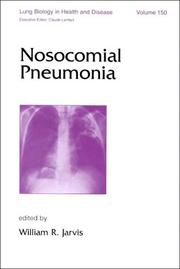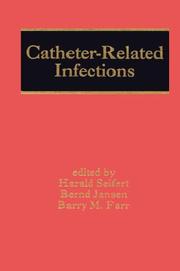| Listing 1 - 10 of 131 | << page >> |
Sort by
|
Book
Year: 2015 Publisher: [Place of publication not identified] : MDPI - Multidisciplinary Digital Publishing Institute,
Abstract | Keywords | Export | Availability | Bookmark
 Loading...
Loading...Choose an application
- Reference Manager
- EndNote
- RefWorks (Direct export to RefWorks)
The well-known persistence in the nosocomial environment of multidrug resistant bacterial and fungal species, today responsible for a wide variety of healthcare-associated infections, is believed to be greatly promoted by the ability of most of them to adhere and to grow in sessile mode on mucosal and soft tissues of hospitalized patients, as well as on the inner and outer surfaces of indwelling medical devices, including intravenous catheters, orthopaedic, cardiac valves, intrauterine devices, and contact lenses. In this regard, a large number of these microorganisms, such as Acinetobacter baumannii, Candida albicans, Escherichia coli, Klebsiella pneumoniae, Pseudomonas aeruginosa, and Staphylococcus aureus, give rise to highly organized, sessile community defined biofilms, in which microbes grow encased in a hydrated matrix of extracellular polymeric substances produced by themselves and are well protected from the attack of antimicrobial molecules and from the host immune response, by resisting phagocytosis and other body's defense systems. The great influence of the sessile growth on the effectiveness of the antibiotic therapies is due to both the structure and function of these microbial communities, making these also 1000 times more tolerant to antibiotics and disinfectants. Thus, alternative approaches to the common antibiotic treatments are emerging for preventing and treating both the mono-species and the most frequent multi-species biofilms, including enzymes able to disrupt mature biofilms and new biomaterials for the coating of medical devices to counteract microbial adhesion and biofilm formation. The aim of this Special Issue is to report on the state-of-art of the basic and applied research in the field of biofilm-based nosocomial infections that can be acquired by patients in both general hospitals and long-term care settings. Particularly, the involvement of microbial biofilms in medical device-related infections and other healthcare-associated infections, so far underestimated and/or scarcely investigated, has been considered, reviewed, and discussed.
Book
Year: 2015 Publisher: [Place of publication not identified] : MDPI - Multidisciplinary Digital Publishing Institute,
Abstract | Keywords | Export | Availability | Bookmark
 Loading...
Loading...Choose an application
- Reference Manager
- EndNote
- RefWorks (Direct export to RefWorks)
The well-known persistence in the nosocomial environment of multidrug resistant bacterial and fungal species, today responsible for a wide variety of healthcare-associated infections, is believed to be greatly promoted by the ability of most of them to adhere and to grow in sessile mode on mucosal and soft tissues of hospitalized patients, as well as on the inner and outer surfaces of indwelling medical devices, including intravenous catheters, orthopaedic, cardiac valves, intrauterine devices, and contact lenses. In this regard, a large number of these microorganisms, such as Acinetobacter baumannii, Candida albicans, Escherichia coli, Klebsiella pneumoniae, Pseudomonas aeruginosa, and Staphylococcus aureus, give rise to highly organized, sessile community defined biofilms, in which microbes grow encased in a hydrated matrix of extracellular polymeric substances produced by themselves and are well protected from the attack of antimicrobial molecules and from the host immune response, by resisting phagocytosis and other body's defense systems. The great influence of the sessile growth on the effectiveness of the antibiotic therapies is due to both the structure and function of these microbial communities, making these also 1000 times more tolerant to antibiotics and disinfectants. Thus, alternative approaches to the common antibiotic treatments are emerging for preventing and treating both the mono-species and the most frequent multi-species biofilms, including enzymes able to disrupt mature biofilms and new biomaterials for the coating of medical devices to counteract microbial adhesion and biofilm formation. The aim of this Special Issue is to report on the state-of-art of the basic and applied research in the field of biofilm-based nosocomial infections that can be acquired by patients in both general hospitals and long-term care settings. Particularly, the involvement of microbial biofilms in medical device-related infections and other healthcare-associated infections, so far underestimated and/or scarcely investigated, has been considered, reviewed, and discussed.
Book
Year: 2015 Publisher: [Place of publication not identified] : MDPI - Multidisciplinary Digital Publishing Institute,
Abstract | Keywords | Export | Availability | Bookmark
 Loading...
Loading...Choose an application
- Reference Manager
- EndNote
- RefWorks (Direct export to RefWorks)
The well-known persistence in the nosocomial environment of multidrug resistant bacterial and fungal species, today responsible for a wide variety of healthcare-associated infections, is believed to be greatly promoted by the ability of most of them to adhere and to grow in sessile mode on mucosal and soft tissues of hospitalized patients, as well as on the inner and outer surfaces of indwelling medical devices, including intravenous catheters, orthopaedic, cardiac valves, intrauterine devices, and contact lenses. In this regard, a large number of these microorganisms, such as Acinetobacter baumannii, Candida albicans, Escherichia coli, Klebsiella pneumoniae, Pseudomonas aeruginosa, and Staphylococcus aureus, give rise to highly organized, sessile community defined biofilms, in which microbes grow encased in a hydrated matrix of extracellular polymeric substances produced by themselves and are well protected from the attack of antimicrobial molecules and from the host immune response, by resisting phagocytosis and other body's defense systems. The great influence of the sessile growth on the effectiveness of the antibiotic therapies is due to both the structure and function of these microbial communities, making these also 1000 times more tolerant to antibiotics and disinfectants. Thus, alternative approaches to the common antibiotic treatments are emerging for preventing and treating both the mono-species and the most frequent multi-species biofilms, including enzymes able to disrupt mature biofilms and new biomaterials for the coating of medical devices to counteract microbial adhesion and biofilm formation. The aim of this Special Issue is to report on the state-of-art of the basic and applied research in the field of biofilm-based nosocomial infections that can be acquired by patients in both general hospitals and long-term care settings. Particularly, the involvement of microbial biofilms in medical device-related infections and other healthcare-associated infections, so far underestimated and/or scarcely investigated, has been considered, reviewed, and discussed.

ISBN: 0824703847 Year: 2000 Publisher: New York (N.Y.): Dekker
Abstract | Keywords | Export | Availability | Bookmark
 Loading...
Loading...Choose an application
- Reference Manager
- EndNote
- RefWorks (Direct export to RefWorks)
Book
Year: 1987 Publisher: Gent Ecosystems International N.V.
Abstract | Keywords | Export | Availability | Bookmark
 Loading...
Loading...Choose an application
- Reference Manager
- EndNote
- RefWorks (Direct export to RefWorks)
Book
Abstract | Keywords | Export | Availability | Bookmark
 Loading...
Loading...Choose an application
- Reference Manager
- EndNote
- RefWorks (Direct export to RefWorks)

ISBN: 0824798481 Year: 1997 Publisher: New York Basel Hong Kong Dekker
Abstract | Keywords | Export | Availability | Bookmark
 Loading...
Loading...Choose an application
- Reference Manager
- EndNote
- RefWorks (Direct export to RefWorks)
Book
Year: 2018 Publisher: Brugge Die Keure
Abstract | Keywords | Export | Availability | Bookmark
 Loading...
Loading...Choose an application
- Reference Manager
- EndNote
- RefWorks (Direct export to RefWorks)
Book
Year: 2008 Publisher: [Washington, D.C.] : U.S. Govt. Accountability Office,
Abstract | Keywords | Export | Availability | Bookmark
 Loading...
Loading...Choose an application
- Reference Manager
- EndNote
- RefWorks (Direct export to RefWorks)
Nosocomial infections --- Nosocomial infections --- Prevention. --- United States. --- Rules and practice.
Book
Year: 2008 Publisher: [Washington, D.C.] : U.S. Govt. Accountability Office,
Abstract | Keywords | Export | Availability | Bookmark
 Loading...
Loading...Choose an application
- Reference Manager
- EndNote
- RefWorks (Direct export to RefWorks)
Nosocomial infections --- Nosocomial infections --- Prevention. --- United States. --- Rules and practice.
| Listing 1 - 10 of 131 | << page >> |
Sort by
|

 Search
Search Feedback
Feedback About UniCat
About UniCat  Help
Help News
News